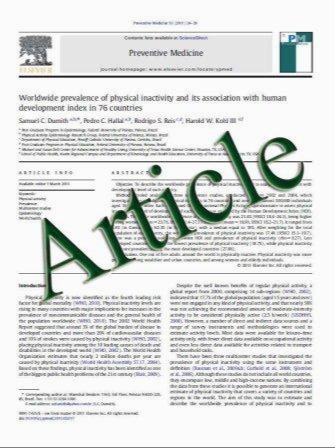Age-related hyperkyphosis, independent of spinal osteoporosis, is associated with impaired mobility in older community-dwelling women
- نوع فایل : کتاب
- زبان : انگلیسی
- مؤلف : W. B. Katzman & E. Vittinghoff & D. M. Kado
- چاپ و سال / کشور: 2010
Description
Summary While many assume hyperkyphosis reflects underlying spinal osteoporosis and vertebral fractures, our results suggest hyperkyphosis is independently associated with decreased mobility. Hyperyphosis is associated with slower Timed Up and Go performance times and may be a useful clinical marker signaling the need for evaluation of vertebral fracture and falling risk. Introduction While multiple studies have demonstrated negative effects of hyperkyphosis on physical function, none have disentangled the relationship between hyperkyphosis, impaired function, and underlying spinal osteoporosis. The purpose of this study is to determine whether kyphosis, independent of spinal osteoporosis, is associated with mobility on the Timed Up and Go, and to quantify effects of other factors contributing to impaired mobility. Methods We used data for 3,108 community-dwelling women aged 55-80 years in the Fracture Intervention Trial. All participants had measurements of kyphosis, mobility time on the Timed Up and Go test, height, weight, total hip bone mineral density (BMD), grip strength, and vertebral fractures at baseline visits in 1993. Demographic characteristics included age and smoking status. We calculated mean Timed Up and Go time by quartile of kyphosis. Using multivariate linear regression, we estimated the independent association of kyphosis with mobility time, and quantified effects of other covariates on mobility. Results Mean mobility time increased from 9.3 s in the lowest to 10.1 s in the highest quartile of kyphosis. In a multivariate-adjusted model, mobility time increased 0.11 s (p=0.02) for each standard deviation (11.9پ‹) increase in kyphosis. Longer performance times were significantly associated with increasing age, decreasing grip strength, vertebral fractures, body mass index .25, and total hip BMD in the osteoporotic range. Conclusions Kyphosis angle is independently associated with decreased mobility on the Timed Up and Go, which is in turn correlated with increased fall risk. Hyperkyphosis may be a useful clinical marker signaling the need for evaluation of vertebral fracture and falling risk.
Osteoporos Int (2011) 22:85–90 DOI 10.1007/s00198-010-1265-7 Received: 14 November 2009 / Accepted: 9 March 2010 / Published online: 18 May 2010


